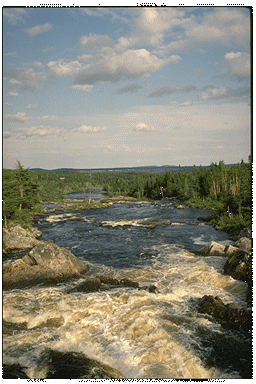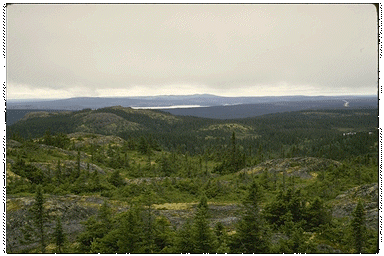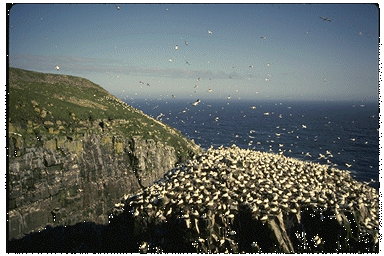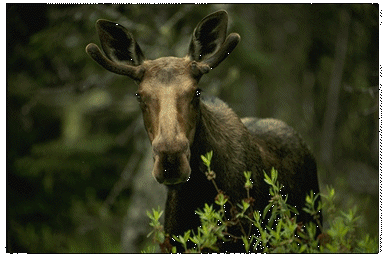
BOREAL BY THE SEA
...the country in all directions ... appeared to be covered with one dense unbroken pine forest, with here and there a bold granitic pap projecting above the dark-green surface .... Wind-fallen trees, underwood, and brooks lay in our way, which, together with the suffocating heat in the woods, and mosquitoes, hindered us from advancing more than five miles on this day....
William Cormack, 1822
The only known European to walk across Newfoundland.

THE LAND:
The eroded remains of the ancient Appalachian Mountains give this region a rugged, hilly countenance. Along the coast in many places, sea cliffs rise precipitously 200-300 metres. Inland are innumerable lakes and rocky, fast-flowing rivers. The wounds left by the passing of the glaciers have not healed over much of the region. Large areas of exposed bedrock where the soil has been scraped away remain. Other areas are covered by glacial till. Lichen-encrusted erratic boulders perch on barren hilltops.

VEGETATION:
About one-half of the region is covered by a boreal forest of black spruce and balsam
fir. Near the coast, an understory of feathermoss thrives in the moist sea air. Inland,
nearly pure stands of balsam fir occur on well-drained sites. In the hilly country and
along protected valleys the forest is very productive and supports a thriving
pulp-and-paper industry. Much of the original forest has been altered by human-caused
fires. Bogs cover much of the region.

WILDLIFE:
"One of the most striking features of the interior is the innumerable deer-paths on the savannas. They ... take directions as various as the winds, giving the whole country a chequered appearance. Of the millions of acres here, there is no one spot exceeding a few superficial yards that is not bounded on all sides by deer-paths...."
William Cormack, 1822
Although the Strait of Belle Isle separating Newfoundland from the mainland is only 18 kilometres across, it has proven to be an effective barrier to many species of wildlife. Only 14 species of mammals are native to Newfoundland, compared to 42 species on the adjacent mainland. Many species, such as the moose, snowshoe hare and red squirrel have been introduced and are now thriving. Some native species have only recently made the crossing. Lynx, for example, were not mentioned until the turn of the century. Other native species include the black bear, red fox, beaver, mink and caribou. The wolf was once found here, but has been extirpated from the area. The caribou of Newfoundland are a unique sub-species and are the largest in North America.
Along the coastal cliffs and islands of this region are some of the largest seabird rookeries in North America. Cape St. Mary's and the Witless Bay Islands are two of the most accessible and spectacular seabird rookeries in the world. Hundreds of thousands of kittiwakes, puffins, gulls, common murres, razor-billed auks, gannets and millions of Leach's storm petrels breed at these sites. Important seabird colonies are protected as Migratory Bird Sanctuaries or Ecological Reserves. On visiting Funk Island in 1534, explorer Jacques Cartier extolled the abundance and fatness of the birds there. The flightless birds that Cartier was describing were great auks. They were hunted to extinction by 1844.

STATUS OF NATIONAL PARKS
Terra Nova National Park (400 km2) was established pursuant to a federal-provincial agreement in 1957. With its jagged rocky shorelines backed by dense boreal forest, the park protects an outstanding example of this natural region. The fiords or "sounds" that indent the coast are the park's most distinctive feature. Icebergs and whales can often be seen from the headlands framing the fiords. The teeming waters of Bonavista Bay and Newman Sound have attracted fishermen for hundreds of years, and some of Newfoundland's oldest settlements were located in the park.
Inland are numberless bogs and lakes filling depressions gouged out by the passing of glaciers during the Ice Age. Raised bogs, gentle domes rising about 1.5 metres above the surrounding terrain, are common. Sprouting from the sphagnum mosses and lichens are pitcher plants, their curious deep crimson flowers conspicuous among the mainly pastel colours of the vegetation. Other plants that thrive in the acidic conditions found in bogs include Labrador tea, leatherleaf, bog laurel and sundews.
The forest is dominated by black spruce and balsam fir. Much of the forest was logged before the park was established.
The wildlife found in the park is typical of this region. Caribou, once common in this part of Newfoundland, are still occasionally spotted. Moose, introduced to Newfoundland in 1878 and 1904, thrive and are often seen grazing in the park along the Trans-Canada highway. The Newfoundland pine marten has recently been reintroduced in Terra Nova National Park. The Terra Nova River provides fine fishing for Atlantic salmon and speckled trout.